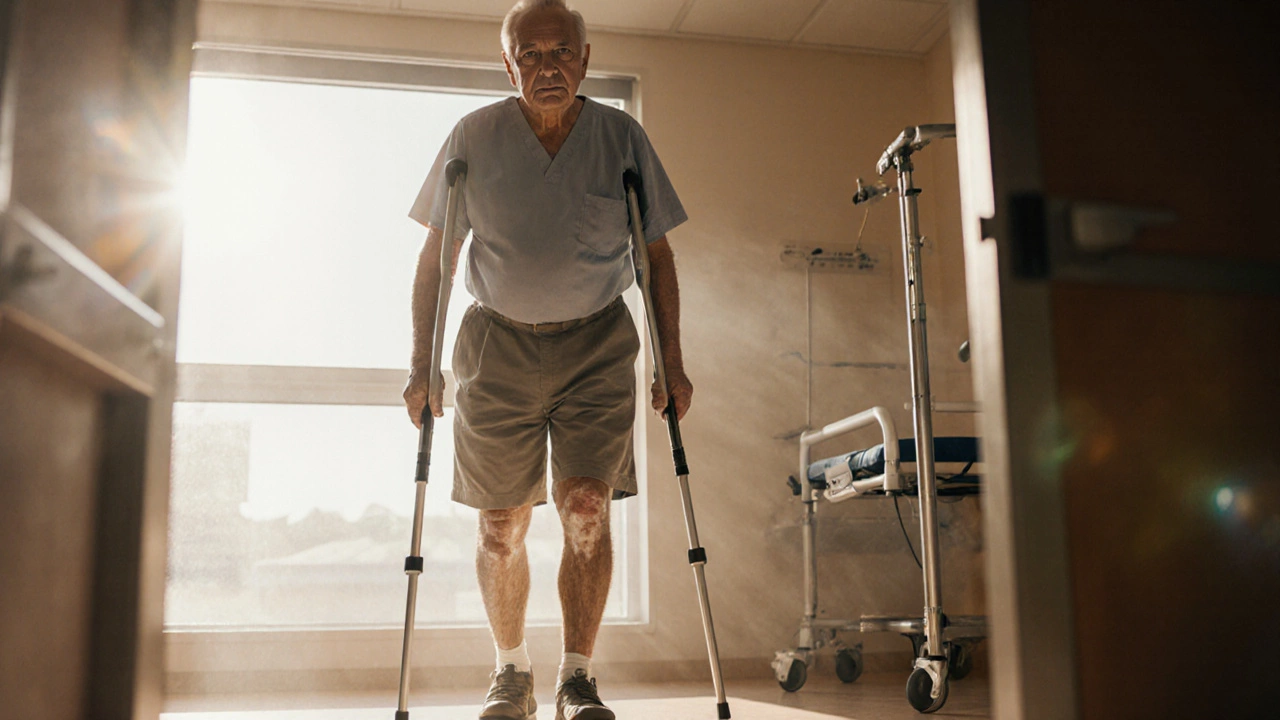Which Surgery Is Worse: Knee or Shoulder? Real Recovery Facts
 Nov, 20 2025
Nov, 20 2025
Recovery Impact Calculator
This tool helps you understand how knee or shoulder surgery might impact your daily life based on your unique situation. Using data from medical studies and real patient experiences, it calculates a recovery difficulty score to help you prepare.
When you’re told you need surgery-whether it’s your knee or shoulder-you don’t just hear the word surgery. You hear fear. You hear months of pain, missed work, canceled plans, and the quiet dread of not knowing if you’ll ever move the same way again. So which is worse: knee or shoulder surgery? The answer isn’t simple. It depends on your life, your body, and what you’re willing to endure.
What Happens During Each Surgery
Knee surgery usually means replacing the joint entirely-total knee replacement-or fixing a torn meniscus or ACL. Most knee replacements involve cutting away damaged bone and replacing it with metal and plastic parts. The knee bears your full body weight, so the implant has to handle constant pressure. Recovery starts the same day: you’re up walking with crutches within 24 hours.
Shoulder surgery is often about repairing the rotator cuff-a group of four tendons that hold your arm in place. These tendons tear from wear, injury, or even just age. The surgery reattaches them to the bone using anchors and sutures. Sometimes, it’s a shoulder replacement, but that’s rarer. Unlike the knee, the shoulder isn’t built for heavy loads-it’s built for movement. So after surgery, your arm is locked in a sling for weeks. No lifting. No reaching. Not even scratching your own back.
Pain Levels: Knee vs Shoulder
Many assume knee surgery hurts more because it’s a bigger joint. But pain isn’t about size-it’s about nerve density and movement. The shoulder has more nerves packed into a smaller space. After rotator cuff repair, patients often describe pain as a deep, constant ache that flares up with even the smallest motion. Sleeping is nearly impossible without pillows propped under the arm. One patient in Birmingham told me she cried every night for three weeks, not because of the wound, but because she couldn’t turn over.
Knee pain is sharp and swelling-heavy, especially in the first week. But because you’re encouraged to move early, the pain tends to ease faster. Painkillers work better on knee inflammation than shoulder stiffness. Shoulder pain doesn’t respond as predictably. Some patients need nerve blocks or long-term anti-inflammatories just to get through the first month.
Recovery Time: Who Waits Longer?
Knee replacement patients typically return to light walking within 4-6 weeks. By 3 months, most can drive, climb stairs, and walk without a cane. Full recovery-meaning no stiffness, no limp-takes 6 to 12 months. But you’re functional long before then.
Shoulder recovery? It’s slower and more fragile. You’re in a sling for 4-6 weeks. Physical therapy starts gently, but progress is measured in millimeters, not miles. Rotator cuff repairs take 4-6 months to heal enough to lift a coffee cup. Full strength? That can take a year. And even then, some people never regain 100% of their range. A carpenter I treated in Solihull couldn’t reach overhead for 14 months. He lost his job.

Mobility Restrictions: The Real Killer
Knee surgery limits how far you can walk or how fast you can move. But you can still do most daily tasks: cook, shower, dress yourself, use your arms. You might limp, but you’re not trapped.
Shoulder surgery turns you into a prisoner of your own body. Simple things become impossible: putting on a shirt, brushing your teeth, reaching for a high shelf, hugging your kids. Even typing on a laptop becomes a struggle. One woman I saw couldn’t wash her hair for six weeks. She had to lean over the sink with a cup of water. That’s not just inconvenient-it’s humiliating.
Long-Term Outcomes: Who Gets Back to Normal?
Knee replacements have a 95% success rate over 15 years. Most people say they wish they’d done it sooner. The pain vanishes. The stiffness lifts. Walking feels free again.
Shoulder repairs are less predictable. Success rates vary between 70% and 85%, depending on the tear size and patient age. If you’re over 60 and your rotator cuff was torn for years before surgery, the tendon might not heal fully. You’ll have less strength. More stiffness. And a higher chance of re-tearing. I’ve seen patients who had two shoulder surgeries and still couldn’t lift their arm past 90 degrees.

Who Has It Worse?
Here’s the truth: if you’re active, independent, and rely on your arms to work or care for others, shoulder surgery is worse. It steals your autonomy. It makes you feel helpless. The pain is harder to control. The recovery is longer. The results are less certain.
If you’re older, less mobile, and your knee pain keeps you from walking to the shop or sitting in the garden, knee surgery gives you your life back. The pain is brutal at first, but it fades. The mobility returns. The improvement is dramatic.
There’s no universal answer. But if you’re trying to decide which surgery you’d rather avoid-most people would pick the knee. Not because it’s easier, but because you can still live while you heal.
What You Can Do to Make It Easier
No matter which surgery you face, preparation matters. Here’s what works:
- Strengthen muscles before surgery. Even light resistance training helps. Stronger muscles = faster recovery.
- Set up your home. Move essentials to waist height. Buy a shower chair. Get a long-handled grabber for picking things up.
- Arrange help. You won’t be able to cook, clean, or drive for weeks. Don’t wait until the day after surgery to ask.
- Stick to rehab. Skipping physical therapy is the #1 reason people don’t get better. Do the exercises-even when it hurts.
- Manage expectations. Recovery isn’t linear. Some days feel like progress. Others feel like backsliding. That’s normal.
When to Choose One Over the Other
If you’re a painter, a builder, or a parent who lifts kids every day-your shoulder matters more. Protect it. Delay surgery if you can. Try injections, physical therapy, or activity modification first.
If you’re a walker, a gardener, or someone who hates the feeling of grinding bone in your joint-your knee is the priority. Don’t wait until you’re stuck at home. Early intervention gives you more options.
Neither surgery is easy. But one is harder to live through.
Is shoulder surgery more painful than knee surgery?
Yes, for most people. Shoulder pain is deeper, more constant, and harder to manage because movement triggers it. Knee pain is sharper but fades faster with movement and medication. Shoulder patients often report worse sleep and more emotional stress during recovery.
How long does it take to recover from knee replacement?
Most people walk without a cane in 4-6 weeks. Driving returns in 4-8 weeks. Full recovery-no stiffness, no limp-takes 6 to 12 months. But you’ll feel significantly better by 3 months. Many say they wish they’d done it sooner.
Can you fully recover from a rotator cuff repair?
It depends. For younger patients with recent tears, full recovery is common. For those over 60 with long-standing tears, full strength and range often don’t return. Studies show 15-30% of patients still have weakness or stiffness after a year, even with perfect rehab.
Which surgery has a higher risk of complications?
Knee replacements have slightly higher risks of blood clots and infection because of the larger incision and weight-bearing stress. Shoulder surgeries have higher rates of stiffness and re-tears, especially if rehab is skipped. Both have low overall complication rates-under 5%-when done by experienced surgeons.
Is one surgery more expensive than the other?
In the UK, both are covered by the NHS. Privately, knee replacements cost slightly more-around £12,000 to £15,000-because of the implant cost. Shoulder repairs are often £9,000 to £12,000. But the real cost is in time off work and care support, which often hits shoulder patients harder.
Should I avoid surgery and try physical therapy first?
For mild to moderate knee arthritis, PT can delay surgery by years. For shoulder tears, PT works well for small, partial tears-but not for full-thickness tears in active people. If your pain stops you from sleeping or doing daily tasks, waiting too long can make surgery less effective. Get imaging first. Then decide with your surgeon.